The train left the Oceanside station
approximately 12:05 PM. We thought the train left late, but it
was scheduled to arrive at Escondido at 1 PM, which it did. Being
up front in the inaugural train, I had a great spot from which to view
the line. To check out the Sprinter line between Oceanside and
Escondido, CLICK HERE.
The train made two stops, at Vista and San
Marcos Civic Center, to pick up more invited guests. Once I
spotted the Sprinter maintenance yard, I figured the end was
near. The train approached the Escondido Station and
stopped. Once everyone was in place, Sprinter train number 1,
moved forward again and broke through the banner.
Once the Sprinter was in her berth,
we detrained and moved around to
the tented celebration area.
Below four photographs, surveying
the Escondido celebration area from
left to right.
Along with the check-in tables,
other tables held programs and Sprinter
gourmet truffle pop candies. Those who were at Escondido before
the inaugural train arrived were treated to entertainment.
As promised, the NCTD had food to be enjoyed. As I was working on
my plate, I noticed the inaugural train operator,
Tino. I asked him how he was selected to drive the inaugural train? He had
several interesting replies. I kept asking him if I could quote
him and finally he said he just viewed the list and "was honored to be
selected." He seemed to be a humble man who was doing his
job. Thanks Tino.

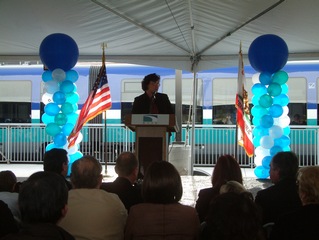
Finally, we found seats and NCTD Executive Director Karen King began
the program of presentations and comments. She started with an
overview of the system, a thank you to local, Federal and State who
made contributions, and a promise that Among her key points, she stated
that before the Sprinter entered revenue service, a few loose ends had
to be tied up, and that the budget and schedule had to be revised a few
times over the years. The Sprinter is the largest project that
their community has seen at $21 million per mile. The Sprinter is the
longest public works project at 22 miles in length. The project
was conceived 30 years ago as an alternate to east-west State Highway
78. They knew that the Sprinter was necessary as the congestion
by 2015 would force mass transit into reality. Ms. King further
stated that the project was "not about the train...we move
people." The Sprinter serves 3 school institutions, 2 hospitals,
one major mall, and commercial and residential. King and the NCTD
take pride about the future and the boost to the local economy
for which the Sprinter created jobs on various levels including
construction, operation and auxilary. Many local companies were
involved and national companies with local offices took part.
King asked "Isn't that train gorgeous?" She made points that it
is
the first non-FRA DMU to be started in service in California.
"The trains are clean and green, built to Euro III standards. The
body and shell are aluminum and fiberglass. They are powered by 2
turbo, intercooled diesels with 5 speed transmissions." They have
a top speed of 55 miles per hour and will run 53 minutes form end to
end. While there were many challenges, we are here to
celebrate th vision of people involved over the decades.
Next up on the poduim, lower left, was Former U.S. Congressman Ron
Packard, the grandfather of the Sprinter. His speech began with
an anecdote whereby the local community leaders had an idea to buy the
Santa Fe rail corridor from Oceanside to Escondid. The railroad
refused to sell. At a later date, with Packard a U.S. Congressman
and the railroads in a troubled business period, the Santa Fe Railroad
president testified as part of Congressional hearings. Packard
approached the railroad president again with the idea of selling the
rail corridor. This set up the chain for the sale to
proceed. Packard, while on the Transportation committee, and
Norman Mineta committee chairman, procured a "full funding
agreement." He admitted that there were some "naysayers here
today" and that they should check back 20 years into the future.
He thanked the NorthCounty citizens for passing a one-half cent sales
tax for the Sprinter. Packard doesn't mind raising taxes "if the
citizens get the benefit of that tax."
Bob Frazee, lower right, another retired legislator, recalled late 19th
century San Diego whereby his grandfather wrote a book beckoning
immigration to San Diego County. At the time, Oceanside was a
railroad town at the confluence of four railroads. There was a
possibility of "another electric railroad" for the 18 miles from
Oceanside to Escondido. Carlsbad had all of 350 citizens, which
got a few laughs from the guests. Mr. Frazee also thanks local
Senator Mills as the father of modern mass transportation. He
recalled making an overnight drive to Sacramento to testify against a
legislative bill that was unfavorable to his constituents. This
set into motion the eventual formation of the North County Transit
District.
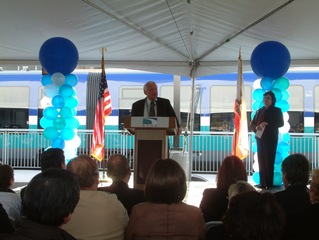
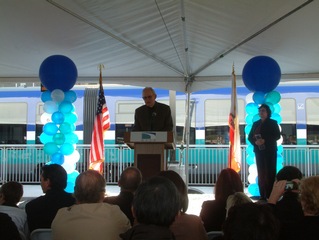
Lower left, Ed Gallo, NCTD Board Chairman representing the City of
Escondido. On the NCTD Board since 2002, Gallo spoke of the
challenging issues bringing the Sprinter to this day. He thanked
the people "at the turn of the century to put in that railroad."
Of course he meant the ones in the late 1800's with the plan for the
first east west rail line. On December 1, 1887 the first trip was
a "picnic trip" and now the trips in our century are to be "beach
trips." He invited the listeners to imagine what the Interstate
would be like without the Coaster and thanked Ron Packard for the "full
funding agreement."
Lower right, Mayor, Escondido, Lori Pfeiler. Her remarks were
very brief and joked that she "had saved her outfit" for this
day. She stressed that "the two corridors give us a choice" for
transportation. In describing the trials and tribulations
of getting the Sprinter to completion she called it "the little
train that could." Believers pushed the train over the hill and
even though other people were on top of the train, they eventually got
off and started pushing too.
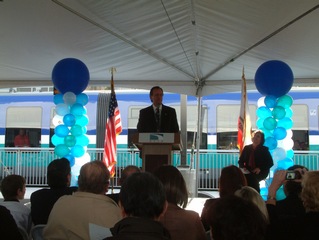
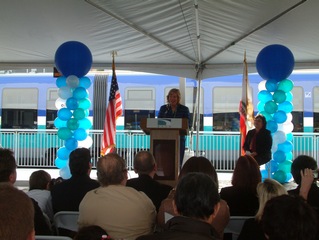
Lower left, Jerome Stocks, NCTD Board Member, representing the City of
Encinitas. Mr. Stocks mentioned how the train is not so much
designed for today's needs, but "for ten, twenty, and fifty years into
the future". He thanked the promoters for "the audacity to stick
with it." Another comment explored the seeming geometrical
skyrocketing of the projects cost with home real estate price
rises. He mentioned the new smooth rail and Euro design of clean
engines.
Lower right, Jack Feller, Councilman, City of Oceanside, recalled
gworing up in a different area of the country and "hopping trains ..in
South Dakota to go hunting." He stressed the idea of getting on
the Sprinter for many reasons excluding hunting. His mention of
highway 76 brought a few boos. He is, however, "glad to have
played a part in this" and thanked "Karen (King) and all her
staff. They have been wonderful people to work with."
Lower left, Judy Ritter, Councilwoman, City of Vista. "I am
truely honored to be here today and to see this actually running.
It is truely a milestone for North County." She spoke of "the
vision to getting high speed rail running down the Escondido Freeway,
the 15, all the way to San Diego, so we can have a whole loop.
She quoted someone who had said that "when the Sprinter ran, they
thought hell would freeze over" and gave the good news "the Sprinter's
running!"
Lower right, David Drucker, Mayor and Councilman, City of Del
Mar. It has taken "walking the halls of Congress" to persuade
support of the Sprinter project since 1996. He also met with
Secretary of Transportation, Norman Mineta who gave the "green light"
to the Sprinter. He called the Sprinter "an important piece of
the mosaic of mass transit in San Diego County." He predicted
that "ultimately people will choose to get out of their cars and use
mass transit" to save their personal time. He "thanked all those
who made this (the Sprinter) possible."
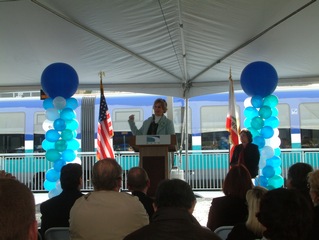
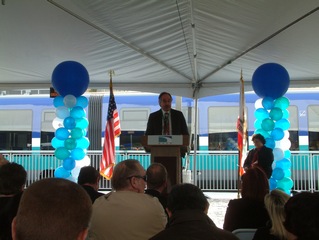
Sprinter
continued